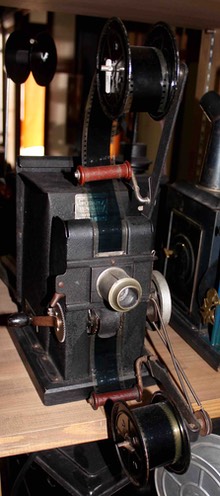
The other week I had to travel to the Kansai area on business and research. I used the opportunity to visit the newly opened Toy Film Museum in the Mibu area of Kyoto.
What are toy films? They have usually been referred to in Japanese as “omocha eiga” (おもちゃ映画) or “gangu eiga” (玩具映画), and have denoted modes of watching cinema in the home in the early years of the medium. While we are familiar with small gauge films (kogata eiga 小型映画) like 8mm—or the 9.5mm Pathé Baby format popular in the prewar—that came to be defined as the mode for home movies, the motion pictures did not necessarily enter the home in such formats. Much larger gauges—including 35mm film—were actually common as a home movie system confined to projection. You might be surprised at that if you know of the huge projectors that exist (or existed) in theaters for 35mm projection, but in fact from the 1910s, there were small tin 35mm projectors produced in Europe and North America, the first working off of oil lamps, the later ones off of electric light, that could be used at home. With small spools of film and cranked by hand, they could present films a few minutes long. The picture on the left is of a foreign-made projector with the film loaded that is on display at the Museum.
What were these films? The term “home movies” itself now connotes a film aesthetic, as well as a mode of production. The format that goes along with that tends to be the smaller gauges like 8mm that became popular in part because they allowed for easy filming as well. But the first home movies were actually often pre-made films. Some were produced by the company that manufactured the projectors (the software that came with the hardware), but in Japan at least, some were actually excerpts of theatrical feature films. Below are a few of the films on display at the Museum that companies included with their projectors.
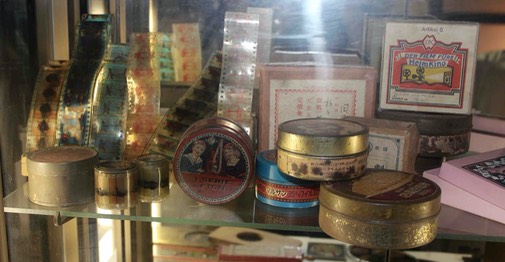
This phenomenon reminds us that the new media are rarely that new. Video tapes and DVDs were not the first occasion for people to watch films at home, not even of theatrical films. Television was also not the first time that moving image screen media could be viewed at home. There is the question of distribution, since it is likely that toy films were expensive enough that only those in the middle class and above could regularly consume them. But it also took a while before television, at least in Japan, was affordable to the majority of the population. Toy films might not have had that time because the coming of sound put a damper on the attraction of the apparatus, since none could handle sound. Nevertheless, the Toy Film Museum’s preservation of these “home movies” is a reminder of the history of enjoying cinema at home that has often been forgotten, even though it began soon after the medium was invented.
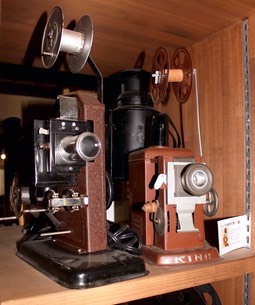
The Toy Film Museum began as the Toy Film Project, an effort by Ota Yoneo of the Osaka University of Arts to collect the films made for toy projectors. As mentioned above, some came with the projectors or were sold by the manufacturer, but some were versions of theatrical films, from shorts to feature films. Some were animated, but many were live action films. One of the goals of the Toy Film Project was to preserve these films because, given that the vast majority of pre-WWII Japanese films are lost, these one to three minute film fragments are the only parts to remain of some important films. Ota has appeared a few times on TV introducing some of his finds. He has digitized many of the films he has found and has made them available for viewing at the Museum. It was later that he began collecting the projectors, including some manufactured in Japan, such as the King projector to the left.
Ota decided to start the Museum in part because he was disappointed that Kyoto, which was long called the Hollywood of the East for its active film production, has no museum dedicated to film. While the Museum is now focused on toy films, its ambition is to introduce a broader conception of film culture. It also displays other apparatuses, from pre-cinematic devices to Pathé Baby projectors. They even have a Refcy projector, which worked not on celluloid but on paper film (a strong light was shown on the paper and it was the reflected light that was projected).
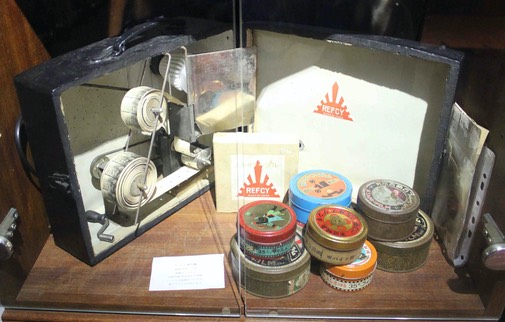
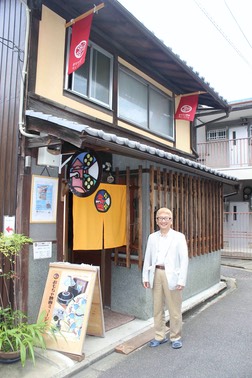
The Museum is now basically a “mom and pop” operation, run by Ota and his wife (the photo to the right is of Ota-sensei in front of the Museum). It is located inside an old Kyoto building once occupied by a company involved in Mibu’s cloth dyeing industry. You enter via a narrow hallway with an exhibition room to the right which used to be where the company displayed its goods. The back, where the dyeing was done, is now a space for viewing films and having events. The Museum charges a small admission fee, but this is a small operation that mostly runs on the Ota family budget and donations. They sell memberships, which include some special perks. A plus is that the Museum is hands on: you are allowed to touch and play with many of the items on display. There are also some nice original goods—T-shirts, DVDs, cups and buttons—that are on sale. You can check out their YouTube channel for a sample of some of the films.
I had a great visit with my wife and my student, Noriko Morisue, who gave a talk at the museum a week before. The Museum featured our visit on their blog, mentioning that Markus Nornes and I included an entry on the museum in the Japanese version of our Research Guide to Japanese Film Studies.
I recommend a visit by any film lover visiting Kyoto.

